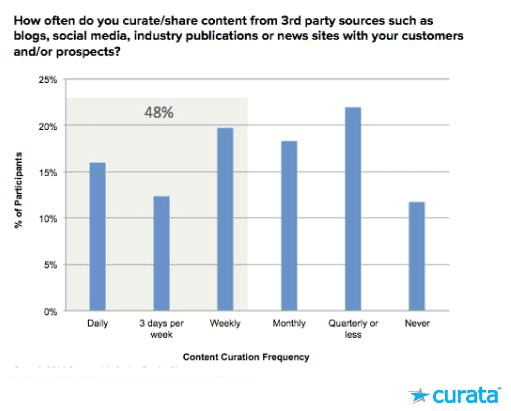Content curation may seem simple, but if you don’t follow these content curation best practices, you may be doing more harm than good for your organization’s social channels.
Having recently successfully managed a social media program for a client in which 99 percent of the content published was curated, I can speak firsthand as to the power of content curation to empower a social media strategy. Content is the currency of social media, but that doesn’t necessarily mean that the burden of all content creation falls on you! The beautiful thing is that there is an almost unlimited treasure trove of content that is still waiting to be searched for, discovered, and reused.
I’ve been writing about content curation for a few years, so I wanted to take the opportunity here to outline what I think are the best practices you should be following in your content curation.
Always Place Audience Interest at Number One
The rest of the entries on this list go down the drain without practicing this one first. You must decide who your audience and their interests are. Your content curation ROI heavily depends on how you engage your customers and how they respond to you. Feeding your audience content that they have no interest in could certainly backfire.
You want to grab your audience’s attention, right? Make sure to identify what is relevant, interesting, thought provoking, and emotion evoking to your audience. Provide content that matters to them.
It is true that we are in the marketing business and we should be focusing on marketing and sales. But look at the big brands creating commercials that are heart-warming, inspiring, and at times filled with tear-jerking stories. The brands do this to elicit emotions from their audience; this is also a way of gaining their trust.
Once you have gained your audience trust and curiosity, everything will follow like a stack of dominoes.
Always Pair Quality With Quantity
Quality and quantity are now a couple. They don’t want to be separated anymore. Your audience does not want quality and quantity separated as well.
Creating a large volume of low-quality curated content won’t get your audience’s attention anymore in the noisy social media world of today. At the same time, publishing curated content of high quality on an infrequent monthly basis would miss out on a lot of opportunities.
The graph shown below courtesy of Curata shows the frequency marketers perform curation-related activities.

Don’t be afraid to publish curated content three to four times per week or more. You can automate it by queueing your posts ahead of time. But note that some content might be time sensitive and you would want to publish them right away.
Ensuring that your content is of high quality can take a chunk of your time. Develop a systematic process that is comfortable for you and raise your content curation operations to the next level. You will reap the rewards for this.
Create a Personal Database for Content Sources
Collecting data from a variety of sources can expedite the whole curation process big time. This can also transform your efforts and procedures into a more holistic approach. The process can be applied to all aspects of the business — which can definitely save a lot of resources.
Here is some of the data that is very important to collect:
- URLs of everybody connected to your business, such as industry associations, customers, partners, and ecosystem players
- Social media accounts and blogs of the above, but make sure you choose those that seem most active and relevant
- Newsletters of your choice from the above that seem to offer the most valuable information
- Keywords to be used for web alerts and notifications
- RSS feeds
There are a lot of content curation sources for you to choose from. Determine what type of material you may need in your curation then make a list of the sources where you can dig deeper to find such content. Remember that a well-organized database can help in optimizing the whole content curation process.
Get Your Arsenal of Curation Tools Ready
Content curation is not a walk in the park. The whole process can definitely eat much of your valuable time. Fortunately, there are tons of content curation tools that marketers can utilize at their own disposal. These tools are classified according to their use during the whole content curation process.
Marketers and curators can save a lot of time once they learn and decide which of the tools fit with their curation needs and practices. Once you decide to use these tools, it is advised to make sure they perform with accuracy and reliability.
Here is a list of some of the top content curation tools I personally recommend:
- Curata. The industry-leading content curation tool for enterprises. Period.
- Feedly. Aggregate your RSS feeds to help you more efficiently curate content.
- Storify. A great way of not only curating content but also publishing that curated content in a “storified” format.
- Paper.li. A Twitter-centric approach to finding and providing content to curate.
- List.ly. The definitive list-based content curation tool.
- Scoop.it. A great tool which helps you from curation to publication.
- TagBoard. Great way to curate content centered on hashtags.
- Pocket. When you don’t have time to sift through the content you curated, simply save it in Pocket for further reading.
- Newsle. Great way to find the latest news on people you want to keep an eye on.
- PostPlanner. Using PostPlanner to curate content for Facebook contributed to a 173 percent increase in website traffic from Facebook.
Find the Rare Gems and Share Them
Following trends may be a good way to go whenever you are trying to come up with ideas for your content creation. This is a smart way of exposing your brand and company to a new group or audience. This may sound easy but you still have to get out of the pack. A lot of marketers are doing this nowadays. You have to do something that is unique to what others do.
How do you do that?
Find the pearls at the bottom of the ocean. There is a lot of valuable content out there that most people simply haven’t seen because of the democratization of information. Be the first to discover and share them. This is where your customized RSS feed comes in handy. RSS alerts arrive in real time. Tools like Feedly and Digg Reader are just two of the useful tools for this practice.
Always keep in mind the kind of content that will be beneficial to your business and as well as to your audience. Prioritize them.
Create Curated Content That Can Be Used on Multiple Platforms
People nowadays frequently use different social media platforms. Keep that in mind when creating your curated content. Make sure to include in your plan the platforms you will be using in spreading your content.
Identify where your targeted audience usually hangs out. If they love to linger on YouTube, create videos for them. But also keep in mind that your video could also be shared and posted on Facebook. The same can be said for image-related content you can post on Instagram, Pinterest, and Twitter.
Creating content with the purpose of sharing it across multiple platforms is a faster way of increasing reach and following. Curate once — use everywhere.
It Is Still About the Headline
Have you noticed what Upworthy, BuzzFeed, and the Huffington Post have in common? They usually produce most of the viral content on the internet today. They also produce content with the most captivating headlines. These guys and gals really know how it’s done.
The headline game is still on today. Your curated content’s headline can make or break the success of your work.
Hone your skill and creativity in formulating headlines that are compelling, interesting, and captivating to say the least. Doing this will help you to ensure high click-through rates.
Make Content Curation a Team Effort
Content curation can be more fun and effective if your team is involved in the whole process. This is a social activity. With more people involved, the speed and efficiency of the whole process would also exponentially increase.
Another benefit of cultivating content curation within your organizational culture is that it will also produce team members who are constantly updated to information that is relevant to their work. In time, your team’s quality of work will also improve, which will also bring your business to greater heights. A win-win situation indeed.
For companies that want to implement an advocacy program for their employees, you can also perform content curation for both your marketing efforts and for the employees’ benefit as well.
Learn to Love Metrics and Analytics
All your marketing efforts become doomed if you do not use metrics and analytics to check how your efforts performed. This can also be said of content curation. You can see which of your curated content is better received than others by measuring and analyzing the numbers and then optimize by content theme and sources moving forward.
Believe it or not, 40 percent of people who perform curation do not measure how well it performed. Don’t become one of them!
Make the Original Creators Proud
Do not forget to give credit where it’s due. What is most important is to give justice to the original owner’s work. Try to impress the curated material’s creators. This would likely make them share your work with their own followers — who may eventually also follow you.
You can send a thank-you note to the owners or mention them in your curated material. Do not forget to include a link to the original article. Copying and publishing the entirety of the source material is a big no-no.
Also, when deciding which content you want to curate and share, bring into consideration the reputation of the original creator. Make sure the creator has the authority and the credibility that can easily gain the reader’s trust.
Make sure to follow a good framework in the creation of your curated content.
Dominate Through Content Curation
Content curation works like a magnetic sponge as it collects a large chunk of information then attracts readers who eventually become customers of your thriving business. As you regularly collect and share your curated content, your influence, network, and following will also grow.
These are the best practices in content curation that I recommend. Do you agree with the list? Anything missing? Please share your thoughts in the comment section below or on Twitter.


